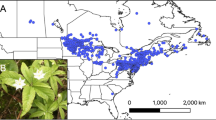Summary
Two closely related long-lived rosette plants in the genusLobelia occur on alpine Mount Kenya.Lobelia telekii grows in drier sites and is semelparous (dies after first reproduction).Lobelia keniensis grows in wetter sites and is iteroparous (flowers repeatedly). I used long-term data to evaluate two related models of the evolution of semelparity (‘reproductive effort’ and ‘demographic’), and found evidence to support only one. Eight years of population data indicate that a simple mathematical model accurately describes the demographic conditions that have favoured the evolution of semelparity. In drier sites,Lobelia individuals flower so infrequently and suffer such high mortality between reproductive episodes that the probability of future reproduction is outweighed by the greater fecundity associated with semelparity.
Similar content being viewed by others
References
Abrahamson, W. G. (1979) Patterns of resource allocation in wildflower populations of fields and woods.Amer. J. Bot. 66, 71–9.
Acker, C. L. (1982a) Regulation of flower, fruit and seed production by a monocarpic perennial,Yucca whipplei.J. Ecol. 70, 357–72.
Acker, C. L. (1982b) Spatial and temporal dispersal patterns of pollinators and their relationship to the flower strategy ofYucca whipplei (Agavaceae).Oecologia 54, 243–52.
Bell, G. (1976) On reproducing more than once.Amer. Natur. 110, 57–77.
Bell, G. (1980) The costs of reproduction and their consequences.Amer. Natur. 116, 45–76.
Charnov, E. and Schaffer, W. M. (1973) Life history consequences of natural selection: Cole's result revisited.Amer. Natur. 107, 791–3.
Fone, A. L. (1989) A comparative study of annual and perennialHypochoeris (Asteraceae).J. Ecol. 77, 495–508.
Gaines, M. S., Vogt, K. J., Hamrick, J. L. and Calwell J. (1974) Reproductive strategies and growth patterns in sunflowers (Helianthus).Amer. Natur. 108, 889–94.
Leibengut, C. (1986)Hydrogeological map of Mount Kenya. African Studies Series, Vol. A3. Geographica Bernesia, Berne.
Marshall, D. L., Fowler, N. L. and Levin, D. A. (1985) Plasticity in yield components in natural populations of three species ofSesbania.Ecology 66, 753–61.
Michaels, H. J. and Bazzaz, F. A. (1989) Individual and population responses of sexual and apomictic plants to environmental gradients.Amer. Natur. 134, 190–207.
Orzack, S. H. and Tuljapurkar, S. (1989) Population dynamics in variable environments VII. The demography and evolution of semelparity.Amer. Natur. 133, 901–23.
Paige, K. N. and Whitham, T. G. (1987) Flexible life history traits: shifts by scarlet gilia in response to pollinator abundance.Ecology 68, 1691–5.
Pitelka, L. F. (1977) Energy allocation in annual and perennial lupines (Lupinus: Leguminosae).Ecology 58, 1055–65.
Primack, R. (1979) Reproductive effort in annual and perennial species ofPlantago (Plantaginaceae).Amer. Natur. 114, 51–62.
Pyke, G. H. (1981) The evolution of inflorescence size and height in the waratah (Telopea speciosissima): the difficulty of interpreting correlations between plant traits and fruit set. InPollination and Evolution. (J. A. Armstrong, J. M. Powell and A. J. Richards, eds) pp. 91–4. Royal Botanical Gardens, Sydney.
Salisbury, E. J. (1942)The Reproductive Capacity of Plants 244 pp. G. Bell and Sons, London.
Sano, Y., Morishima, H. and Oka, H. (1980) Intermediate perennial-annual populations ofOryza perennis found in Thailand and their evolutionary significance.Bot. Mag. Tokyo 93, 291–305.
Sano, Y. and Morishima, H. (1982) Variation in resource allocation and adaptive strategy of a wild rice,Oryza perennis Meunch.Bot. Gaz. 143, 518–23.
Schaffer, W. M. (1974) Selection for optimal life histories: the effects of age structure.Ecology 55, 291–303.
Schaffer, W. M. and Gadgil, M. V. (1975) Selection for optimal life histories in plants. InEcology and Evolution of Communities (M. L. Cody and J. M. Diamond, eds) Belknap Press, Cambridge, Massachusetts.
Schaffer, W. M. and Schaffer, V. M. (1977) The adaptive significance of variations in reproductive habit in Agavaceae. InEvolutionary Ecology (B. Stonehouse, ed.). Macmillan, London.
Schaffer, W. M. and Schaffer, V. M. (1979) The adaptive significance of variation in reproductive habit in the Agavaceae. II. Pollinator foraging behavior and selection for increased reproductive expenditure.Ecology 60, 1051–69.
Schaffer, W. M. and Rosenzweig, M. L. (1977) Selection for optimal life histories. II. Multiple equilibria and the evolution of alternate reproductive strategies.Ecology 58, 60–72.
Smith, A. P. (1983) Population dynamics of VenezuelanEspeletia. Smithson.Contrib. Bot. 48, 1–45.
Spira, T. P. and Pollak, O. D. (1986) Comparative reproductive biology of alpine biennial and perennial gentians (Gentiana: Gentianaceae) in California.Amer. J. Bot. 73, 39–79.
Struik, G. O. (1965) Growth patterns in some native annual and perennial herbs in southern Wisconsin.Ecology 46, 401–20.
Sutherland, S. D. (1982) The pollination biology of paniculate agaves: documenting the importance of male fitness in plants. PhD diss., University of Arizona, Tucson.
Udovic, D. (1981) Determinants of fruit set inYucca whipplei: reproductive expenditure vs pollinator availability.Oecologia 48, 389–99.
Udovic, D. and Acker, C. L. (1981) Fruit abortion and the regulation of fruit number inYucca whipplei.Oecologia 49, 245–8.
Van Andel, J. and Vera, F. (1977) Reproductive allocation inSenecio sylvaticus andChamaenerion angustifolium in relation to mineral nutrition.J. Ecol. 65, 747–58.
Young, T. P. (1981) A general model of comparative fecundity for semelparous and iteroparous species.Amer. Natur. 118, 27–36.
Young, T. P. (1982) Bird visitation, seed set, and germination rates in twoLobelia species on Mount Kenya.Ecology 68, 1983–6.
Young, T. P. (1984) Comparative demography of semelparousLobelia telekii and iteroparousLobelia keniensis on Mount Kenya.J. Ecol. 72, 637–50.
Young, T. P. (1985)Lobelia telekii herbivory, mortality, and size at reproduction: variation with growth rate.Ecology 66, 1879–83.
Young, T. P. (1990) The population biology of Mount Kenya Lobelias. InTropical Alpine Environments — Plant Form and Function. (P. Rundel, ed.). Springer-Verlag, Berlin.
Author information
Authors and Affiliations
Rights and permissions
About this article
Cite this article
Young, T.P. Evolution of semelparity in Mount Kenya lobelias. Evol Ecol 4, 157–171 (1990). https://doi.org/10.1007/BF02270913
Issue Date:
DOI: https://doi.org/10.1007/BF02270913




